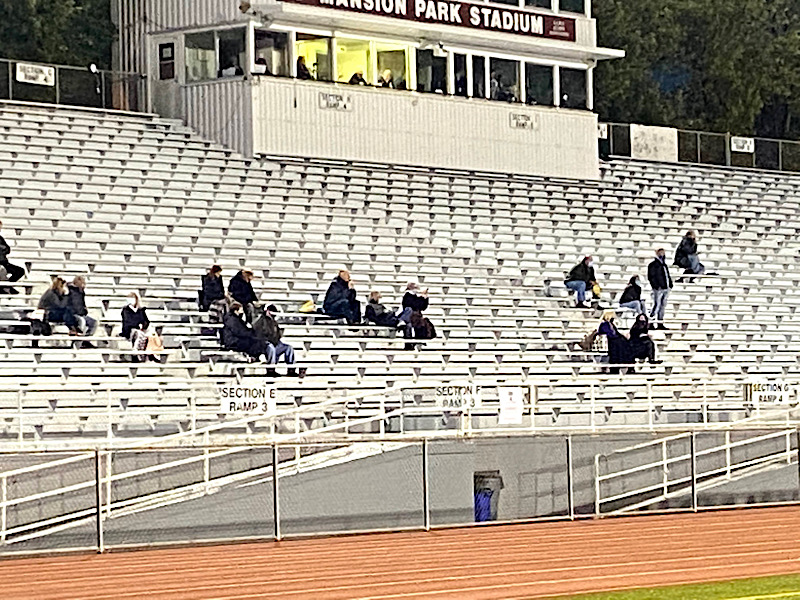
Fan Restrictions eased by Governor
Tagged under: News
Billy Splain | October 6, 2020

scenes like this wont happen this weekend
Last night the Altoona area school district voted to allow 25% occupancy at their sporting venues. Today the governor changed guidelines to allow more fans at events:
Here are the calculators:
Maximum Occupancy Calculator for indoor events:
Maximum Occupancy Allowable Indoor Rate
0-2,000 people 20% of Maximum Occupancy
2,001 – 10,000 people 15% of Maximum Occupancy
Over 10,000 people 10% of Maximum Occupancy up to 3,750 people
Maximum Occupancy Calculator for outdoor events:
Maximum Occupancy Allowable Outdoor Rate
0-2,000 people 25% of Maximum Occupancy
2,001 – 10,000 people 20% of Maximum Occupancy
Over 10,000 people 15% of Maximum Occupancy up to 7,500 people
While thankful this eases things a bit, it’s still, to use the governors words from last week, very confusing. Take for instance: A 2,000 seat facility at 25% capacity can have 500 fans. But, if its a 2,001 seat facility at 20% they can only have 400 fans. However, they did address this situation in a release:
My maximum occupancy is between 2,001-2,664 and 10,001 – 15,000, putting me in the
bottom tier of the bracket in the Maximum Occupancy Calculator, can I reduce my occupancy
load to use the percentage applicable to the lower bracket?
Yes, for purposes of this Order, venues that have a maximum occupancy that is between 2,001
– 2,664 and 10,001 – 15,000 may voluntarily reduce their occupancy load to align with the
lower bracket.
For example, a venue with a capacity of 1,800 occupants will be able to operate with 360
people on site using the 20% guideline. A slightly larger venue that has a capacity of 2,100 is
permitted 315 occupants at the 15% guideline. Venues that fall into that situation may
voluntarily reduce their occupancy load to align with the lower bracket and use that occupancy
percentage.
Press release:
Harrisburg, PA – As Pennsylvanians continue to do their part by adopting healthy behaviors to combat the spread of COVID-19, today Governor Tom Wolf and Secretary of Health Dr. Rachel Levine amended existing COVID-19 orders to allow for adjusted capacity to gathering limits while keeping in place the proven mitigation tools that include wearing masks and maintaining social distancing.
“Pennsylvanians must continue to social distance and wear masks as we prepare to fight the virus through the fall and winter,” Gov. Wolf said. “Regardless of the size of an event or gathering, those things are still imperative to stopping the spread of COVID. We know everyone has sacrificed in many ways and today’s announcement reflects a gradual adjustment to our lives as we learn how we can do things safely until we have a cure, or an effective vaccine is widely available.”
“We will closely monitor cases and outbreaks and if our case investigation and contact tracing efforts determine that events or gatherings are the source of an outbreak, we can and will dial back these new limits,” Dr. Levine said. “Public health and safety are our first concern and will always remain as such.”
Starting on Friday, Oct. 9 amended orders will allow for venue occupancy limits to play a bigger role in determining the number of people permitted both inside and outside of events or gatherings. An event or gathering is defined as a temporary grouping of individuals for defined purposes that takes place over a limited timeframe, such as hours or days, including fairs, festivals, concerts, or shows and groupings that occur within larger, more permanent businesses, such as shows or performances within amusement parks, individual showings of movies, business meetings or conferences, or each party or reception within a multi-room venue.
Conversely, groups of people who share a space within a building in the ordinary course of operations, such as in an office building, classroom, production floor or similar regularly occurring operation of a business or organization, are not events or gatherings.
All businesses are required to conduct their operations remotely through individual teleworking of their employees in the jurisdiction or jurisdictions in which they do business unless that is not possible. In those instances, employees may conduct in-person business operations, provided that the businesses fully comply with the business safety order, the worker safety order, and the masking order.
The orders amend two sections of the July 15 mitigation orders and include a “maximum occupancy calculator” for both indoor and outdoor events. Based on a venue’s established occupancy limit as defined by the National Fire Protection Association (NFPA) Life Safety Code, venues apply the appropriate percent of occupancy to determine how many attendees are permitted to attend an event or gathering.
Here are the calculators:
Maximum Occupancy Calculator for indoor events:
Maximum Occupancy Allowable Indoor Rate
0-2,000 people 20% of Maximum Occupancy
2,001 – 10,000 people 15% of Maximum Occupancy
Over 10,000 people 10% of Maximum Occupancy up to 3,750 people
Maximum Occupancy Calculator for outdoor events:
Maximum Occupancy Allowable Outdoor Rate
0-2,000 people 25% of Maximum Occupancy
2,001 – 10,000 people 20% of Maximum Occupancy
Over 10,000 people 15% of Maximum Occupancy up to 7,500 people
Venues must require attendees to comply with 6-foot social distancing requirements, to wear masks or face coverings, and to implement best practices such as timed entry, multiple entry and exit points, multiple restrooms and hygiene stations. Venues and event planners can review the CDC Events and Gatherings Readiness and Planning ToolOpens In A New Window for additional information regarding best practices.
When not hosting events, occupancy restrictions outlined in the green phase of reopening continue to apply to businesses in the commonwealth.
Any gathering restrictions established by local authorities, such as the ones established in Philadelphia and State College, remain in effect.
For more info:
https://www.governor.pa.gov/wp-content/uploads/2020/10/20201006-Amended-Targeted-Mitigation-FAQ.pdf
Follow PA Football News on Twitter @PaFootballNews







You must be logged in to post a comment.